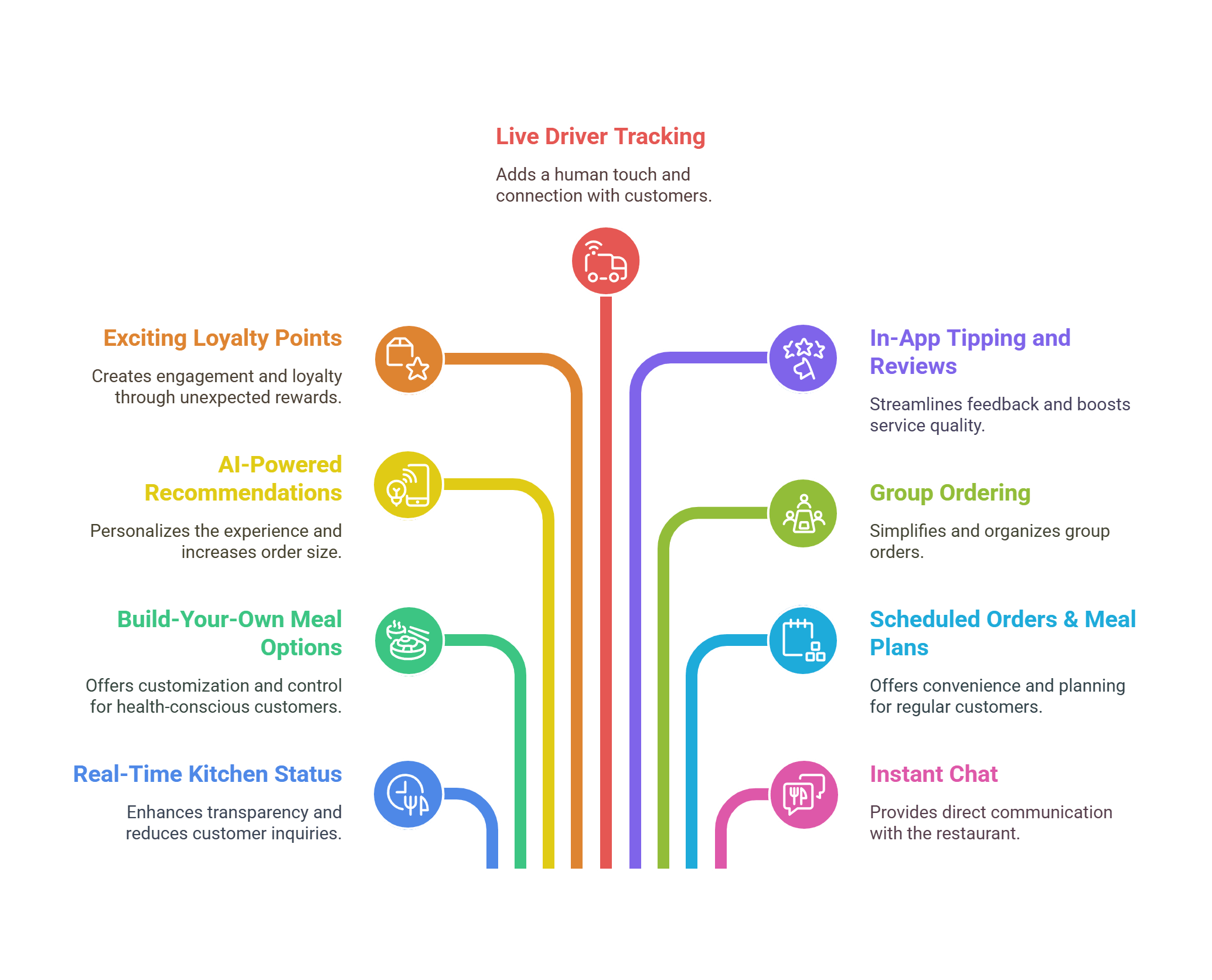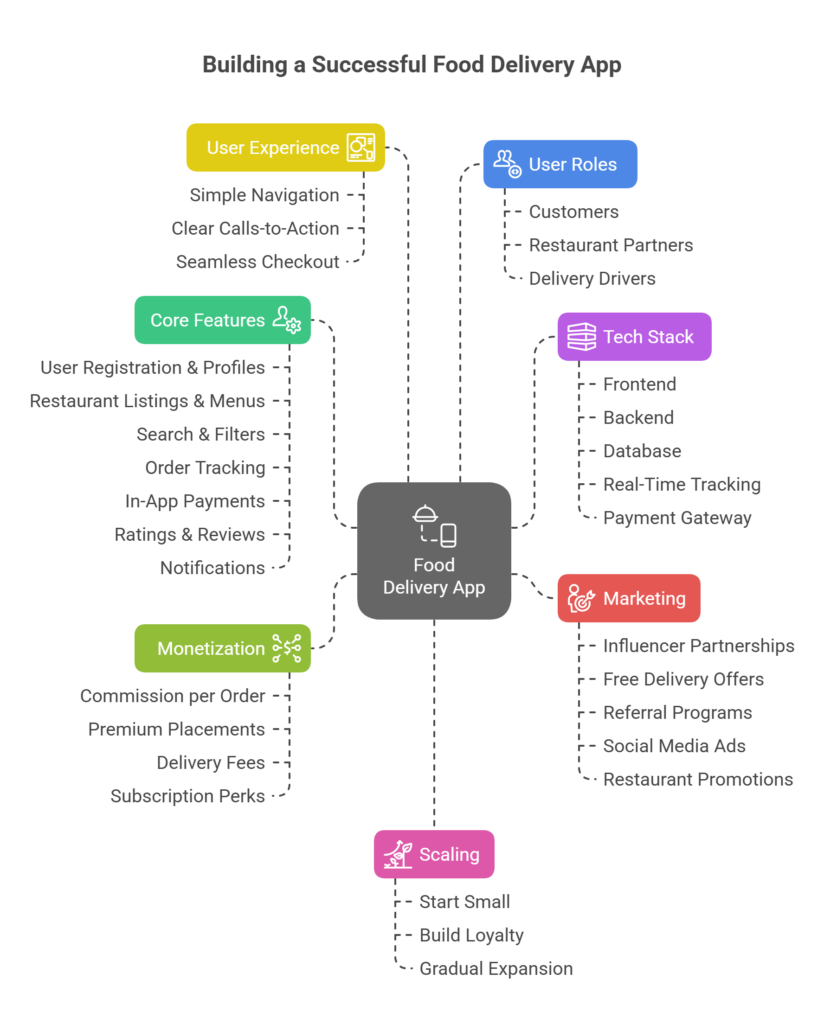Let’s be honest—no one wants to wait in line anymore.
We live in a world where dinner arrives at your doorstep with just a few taps on your phone. Food delivery has gone from being a luxury to a lifestyle. Whether you’re too tired to cook, working through lunch, or binge-watching your favorite show, having a hot, fresh meal delivered right to you is now the norm.
And if you’re a restaurant owner—or someone thinking of launching a food delivery app platform—you’ve probably already realized something: just offering delivery isn’t enough anymore.
With big players like Uber Eats, DoorDash, and Grubhub dominating the market, how do you make your app or service stand out? It’s not about trying to beat them at their own game. It’s about creating an experience your customers actually enjoy—and want to come back to.
That means smart features, a user-friendly design, and little touches that make a big difference.
So, whether you’re dreaming of building your own app or simply want ideas to upgrade your restaurant’s delivery game, here are some creative, practical food delivery app features that can help you stand out in a crowded market.
Top Food Delivery App Features for Restaurants

1. Real-Time Kitchen Status
Ever placed an order and then waited… and waited… with no clue what’s happening? That’s frustrating. Add a feature that shows what stage the order is in—prepping, cooking, packing, or out for delivery. It creates transparency and trust. Plus, it reduces the need for customers to call and ask, “Where’s my food?”
2. Build-Your-Own Meal Options
Customization is king. Let users build their meals from scratch—choose a base, protein, toppings, sauces, etc. Not only is this fun and interactive, but it’s also a great way for health-conscious customers to feel in control of what they’re eating.
3. AI-Powered Recommendations
Use customer data to offer smart suggestions. If someone always orders spicy food or tends to get dessert with dinner, the app can prompt those options automatically. It’s a subtle way to personalize the experience—and increase cart size.
4. Loyalty Points That Actually Excite People
We’ve all seen loyalty programs that feel… underwhelming. Try turning it into a mini game or offering unexpected rewards. For example, “Order 5 times this month and get a surprise dish from the chef.” Make it feel less transactional and more like a relationship.
5. Live Driver Tracking (With Personality)
Instead of a boring dot moving on a map, why not let customers “meet” their delivery driver? A fun bio, a favorite food fact, maybe even a quick video greeting—it adds a human touch. People love connecting with real people, even in small ways.
6. In-App Tipping and Reviews
Keep everything smooth and in one place. After delivery, a clean and easy interface for tipping and leaving feedback helps boost service quality—and shows that the app values both customers and drivers.
7. Group Ordering Made Easy
Perfect for offices or roommates. One person creates a group order link, others add their items, and it’s all compiled into one ticket. It eliminates the messiness of multiple orders and makes sharing food more fun and organized.
8. Scheduled Orders & Meal Plans
Let users schedule orders ahead of time—great for planning lunch during busy workdays. You can even offer curated weekly meal plans for regular customers. Think subscription boxes, but restaurant-style.
9. Instant Chat with the Restaurant
Sometimes people want to ask, “Can I get that with no onions?” or “Is the chicken halal?” Instead of calling, let them message directly from the app. Real-time chat with the kitchen (or a customer support team) adds major convenience.
So You Want to Build a Food Delivery App? Here’s What You Need to Know
If you’re reading this and thinking, “These features sound great—I want to build an app like this!” — awesome. You’re not alone. More restaurants and startups are realizing the power of owning their own food delivery platform instead of relying 100% on third-party apps.
But building a successful food delivery app isn’t just about having a cool design or flashy features. It takes strategy, planning, and a clear understanding of what users (and restaurants) really want.
But First—Ask Yourself These Questions
Before you jump into development mode or hire a team, it’s important to take a step back and ask some honest questions. The answers will shape your entire approach—from features and design to your marketing and business model.
- Who exactly is this app for?
Are you targeting your existing restaurant customers, or are you building a multi-restaurant platform for a broader audience? - What problem are you solving?
Faster delivery? Lower fees? Better food options? Clear answers here will help you build something people actually want. - Do I want to build a marketplace or a single-restaurant app?
There’s a huge difference in complexity and scope. A single-brand app is more focused. A marketplace means managing restaurants, drivers, and customers. - What’s my budget—and timeline?
Be realistic. A polished, reliable app takes time and money. Know your limits so you don’t get stuck halfway. - Will I handle delivery in-house or work with couriers?
This impacts logistics, support, driver tracking features, and your overall business model. - How will I market the app once it’s live?
Building it is only half the journey. You’ll need a solid launch strategy to get users on board. - What makes my app different from the big players?
Is it speed? Local focus? Niche cuisines? Your differentiator will help guide both the user experience and your marketing message.
Image CTA:
Before you build, let’s strategize.
EnactOn’s expert consultation and development teams guide you through every critical question—turning your vision into a clear, actionable plan and a polished app that stands out and scales. Ready to build smarter, not harder? Let’s start the conversation.
Once you’ve got clear answers to those, you’re in a much better place to start building. Now let’s dive into the roadmap.
Food Delivery App Development Roadmap

1. Start with the Basics: Core Features Every App Needs
Before you go wild with custom features, make sure you’ve nailed the essentials:
- User Registration & Profiles
- Restaurant Listings & Menus
- Search & Filters
- Order Tracking
- In-App Payments
- Ratings & Reviews
- Notifications (Push & SMS)
These are the building blocks. Your app needs to be smooth, stable, and easy to use before anything else.
2. Think About the Tech Stack
You don’t have to be a developer yourself, but you do need to know the general layout of what it takes to build an app like this.
Here’s a simplified breakdown:
- Frontend (Mobile App): Built in Swift (iOS) or Kotlin (Android), or using cross-platform frameworks like Flutter or React Native.
- Backend: Node.js, Python (Django), or Ruby on Rails – this handles logic, orders, user data, etc.
- Database: PostgreSQL, MySQL, or MongoDB
- Real-Time Tracking: Use Google Maps API or Mapbox for GPS and delivery routes.
- Payment Gateway: Stripe, PayPal, Razorpay, etc.
If this sounds like another language, that’s totally okay. Just make sure your development team or agency is fluent in it.
3. Design with the End-User in Mind
User experience can make or break your app. Your customers shouldn’t have to think about what to do next—it should feel intuitive.
Tips:
- Keep navigation simple and obvious
- Don’t overload the screen with info
- Use clear calls-to-action (“Add to Cart,” “Track My Order”)
- Make payment and checkout seamless
A great food app should feel like a good waiter: helpful, invisible when not needed, and always there when you are.
Image CTA::
Sounds like too much work?
We’ve walked this path countless times — and we know what works. With EnactOn’s development expertise, your app won’t just launch; it will thrive. Skip the guesswork and build with the confidence of a proven partner who turns complex ideas into seamless, scalable solutions.
4. Build for Two Sides (Maybe Three)
Remember, your app isn’t just for customers. You might need different interfaces for:
- Customers (ordering food)
- Restaurant partners (managing orders)
- Delivery drivers (getting routes, order details)
Each group has very different needs. If you want to build a full ecosystem, plan for this early on.
5. Marketing: You Can’t Just Build It and Hope They Come
Once your app is ready, the real work begins—getting people to use it.
Marketing ideas:
- Partner with influencers or food bloggers
- Offer free delivery for the first X orders
- Create a referral program
- Use social media ads targeting local food lovers
- Work closely with restaurants to promote in-store
Good marketing can turn a functional app into a local sensation.
6. Monetization: How Will You Make Money?
If you’re a restaurant, the benefit is clear—more orders, fewer fees to third parties. But if you’re building a platform for multiple restaurants, consider:
- Charging a commission per order
- Offering premium placements for restaurants
- Charging for delivery or service fees
- Offering subscription perks for loyal users
Make sure your pricing model is fair—for both customers and restaurant partners.
7. Scale Smart, Not Fast
Start small. Focus on one neighborhood or one city. Work out the bugs. Build loyalty. Then grow.
Too many apps go wide too fast, burn through cash, and can’t keep up with support or logistics.
Final Thoughts
Building a food delivery app isn’t just a tech project—it’s a business. You’re creating a full experience that touches people’s daily lives. If done right, it can build community, empower local restaurants, and make customers’ lives better (and tastier).
Whether you’re a restaurateur dreaming of more control, or an entrepreneur spotting a local market gap, take your time, plan well, and build something people will actually love to use.
And hey—if you pull it off, you might just become the next big name in food delivery.
1. How can I promote my food delivery service?
Offer first-time discounts, launch referral programs, and partner with local influencers or restaurants. Promote on social media and food blogs. Use targeted ads and ensure excellent customer service to drive word of mouth. Loyalty rewards and in-app promotions keep users engaged and coming back for more.
2. How long does it take to develop a food delivery app?
A basic app takes 2–3 months; a mid-range version with restaurant and driver dashboards takes 4–6 months. A full-featured platform like DoorDash can take 6+ months. Timelines depend on complexity, features, and whether you’re building from scratch or using a pre-built solution.
3. How much does it cost to create a food delivery app?
Costs range from $15,000 to over $100,000. A basic MVP may cost $15K–$40K, mid-range $50K–$100K, and full-scale platforms can exceed $250K. Pricing depends on features, complexity, and development location. White-label solutions offer a lower-cost, faster-to-launch alternative for many startups or restaurants.
